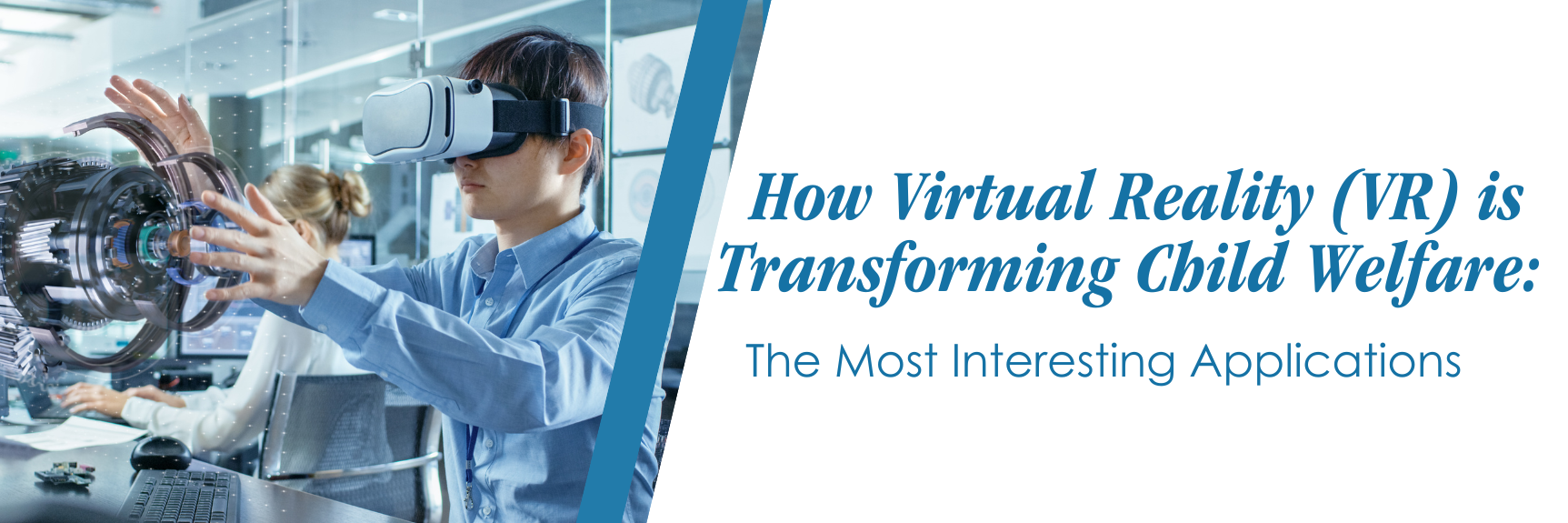
Technology is rapidly reshaping the way we approach child welfare, and Virtual Reality (VR) is emerging as one of the most promising technologies that can be used to enhance service delivery, improve staff training, and provide support for children in care. Gone are the days when VR is only associated with gaming and entertainment; VR is now used to train social workers, support foster children, aid in family reunification and prepare youth for independent living.
For child welfare administrators looking to innovate on a limited budget, VR offers a scalable way to improve outcomes while maintaining security and privacy safeguards. Below, we explore the most compelling applications of VR in child welfare in various stages of development and give suggestions about how agencies can begin implementing and using this amazing technology.
VR for Training and Skill Development in Child Welfare Professionals
One of the most practical uses of VR is to help train your staff of social workers and child welfare professionals. Unlike traditional classroom training, VR provides an immersive, hands-on experience where professionals can practice complex scenarios before encountering them in the field.
Realistic Caseworker Training Simulations
- VR can create real-life scenarios such as home visits, court appointments, abuse assessments, and difficult conversations with children, parents, and caregivers.
- This helps new caseworkers develop confidence and practical experience in a risk-free environment.
- Example: Accenture’s AVENUES solution is one example of how VR is being used to help train staff for fieldwork in child welfare. The Administration for Children and Families also discussed other projects at their 2018 Child Welfare Virtual Expo.
Crisis Intervention and De-Escalation Training
- VR can prepare child welfare workers for high-stress situations (e.g., removing a child from an unsafe home).
- Trainees can practice responses and refine their decision-making skills before facing real-world scenarios.
- Example: The University of Utah’s College of Social Work has piloted VR training to help social workers practice de-escalating intense situations.
Cultural Competency Training
- VR allows child welfare professionals to experience different cultural perspectives, helping them reduce bias in decision-making.
- Agencies can use VR to simulate interactions with families from different socioeconomic and racial backgrounds to improve cultural competence.
VR for Foster Children: Emotional and Social Development
For children in foster care, VR can serve as a powerful therapeutic and developmental tool, helping them stay connected with family, process trauma and develop crucial life skills.
Virtual Family Visitations
- VR can provide real-time, immersive visits between children and distant relatives when in-person visits are not feasible.
- This technology is especially valuable for siblings placed in different homes or when children are placed in out-of-state foster care.
Therapeutic VR for Trauma Recovery
- VR has been used in PTSD treatment for veterans and could soon be explored as a tool to help children process traumatic experiences in a safe and controlled setting.
- Example: VR exposure therapy could help children revisit past experiences in a controlled environment, reducing anxiety and aiding in emotional healing.
Independent Living & Social Skills Training
- VR can simulate real-world experiences like job interviews, grocery shopping, and apartment hunting to prepare aging-out youth for independence.
- Programs like VOISS have already successfully used VR to teach social skills to children with autism, which can be adapted for foster youth.
VR for Biological Family Reunification & Parenting Support
VR is also being used to help biological families work toward reunification and develop healthier parenting techniques.
Virtual Parenting Classes and Simulations
- VR can immerse parents in real-life scenarios, helping them learn positive discipline strategies and improve communication skills.
- Some programs even allow parents to experience the world from their child’s perspective, fostering empathy and better caregiving.
Home Visit Simulations for Risk Assessment
- Child welfare professionals can use VR to practice recognizing signs of neglect or abuse during home visits.
- AI-enhanced VR tools are being developed to train caseworkers to spot safety hazards in homes more effectively.
How can child welfare agencies get started with VR?
Research what your agency needs.
A few minutes of exploration on the web will help you understand how your agency’s staff could most benefit from VR. Use your favorite AI chatbot to ask for unique applications of VR in the child welfare domain. Talk with your staff and colleagues about what they may have seen about VR already.
Leverage grants and Funding Opportunities.
Nonprofits and government agencies can seek funding from sources like the National Science Foundation (NSF) and private foundations, especially those supporting new technologies.
Partner with Universities, Tech Companies, and other Agencies.
Collaboration among various institutions can lower the costs of accessing VR research and help create a community of technology-forward child welfare professionals.
It’s not just video games anymore…
Virtual Reality is no longer just a futuristic concept—it’s already transforming child welfare training, therapy, and family support. While challenges exist, agencies that thoughtfully integrate VR into their services can significantly improve outcomes for children, families, and caseworkers.
We must also remember that, like all technologies, VR should be a complement to training, not a replacement, for human-centered casework. There is no substitute for real-world interactions when it comes to working with children and families in challenging situations. Technology must serve as an entry point to the real world, which personal safety should always be a top concern.
Now is the time for child welfare leaders to explore pilot programs, partnerships, and funding opportunities to leverage VR ethically, affordably and effectively.
by Paul Epp


